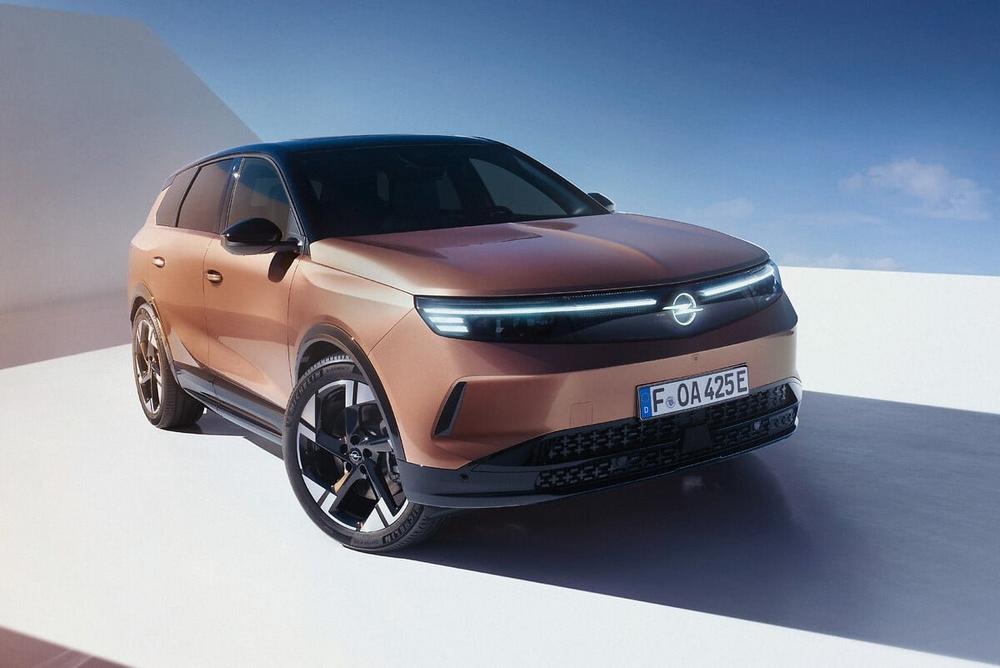- Electric top SUV: Travel up to around 700 kilometres (WLTP1) without charging, locally emissions-free, with the Grandland Electric, batteries as part of the circular economy
- Sustainable, practical, comfortable: Fabrics for seats, door panels and instrument panel made from recycled materials
- Design meets resource conservation: model name embossed in the tailgate, body without chrome elements
Bold, pure and breathtaking – the new Opel Grandland shows what the brand means by “German Energy”. The top SUV features an inspiring design and innovative solutions, focusses on the essentials in terms of operation, and is electrified in every variant. The new Grandland combines a stylish appearance with practical details and many features that reduce the carbon footprint. These include locally emissions-free driving along with recyclable, repairable batteries, as well as the use of recycled materials in the interior and the absence of chrome elements on the body. The newcomer therefore exemplifies “Greenovation made by Opel”.
Stylish, sustainable design: Clear appearance, no chrome elements
The exterior of the new Opel Grandland sets precedents. The Grandland is the first production model to feature the illuminated Opel “Blitz” emblem and integrates this and the innovative “Edge Light” technology into the new 3D Vizor. The lighting uses only energy-saving LED headlights up to and including the industry-leading adaptive Intelli-Lux HD Light.
The rear view of the Grandland also combines style with resource conservation. For the first time, customers see an illuminated OPEL lettering, while the model name GRANDLAND no longer appears in chrome letters but is embossed in the middle of the tailgate – just one example of how Opel has dispensed with chrome applications in the Grandland’s body design.
Practical, comfortable, sustainable: recycled materials in the interior
During development, the designers and engineers paid attention to every detail to find resource-saving solutions to reduce the carbon footprint and at the same time bring a future-oriented, attractive and comfortable SUV onto the road. The cockpit and cabin of the new Grandland were designed to be just as resource-saving as the body. The standard Intelli-Seats, with their recess running down the middle of the seat cushion to relieve pressure on the coccyx, offer relaxed driving pleasure. Not only are they designed to be extremely comfortable, they are also produced sustainably. True to Opel’s “Greenovation” approach, 100 per cent of the fabrics are made of materials with a recycled content. This applies to the seats as well as to the door panels, instrument panel and centre console. Three trims will also be vegan, and even the Alcantara trim will be based on 50 per cent recycled materials.
However, the developers of the new Grandland were not satisfied with that. They placed great importance on not only making the visible parts and components from recycled or recyclable materials, but also the parts that are initially hidden from the eye. For example, the Grandland is made of recycled aluminium as well as steel with recycled content. In addition, the Grandland contains more than 40 polymer parts that consist of up to 80 per cent “green” materials. In total, more than 500 kilogrammes of the Grandland’s weight is made up of recycled and renewable raw materials.
Reducing CO2 emissions: New Grandland electrified in every variant
Of course, Opel also takes the “Greenovation” approach into account when it comes to drivetrains; every Grandland is electrified – as a hybrid with 48-volt technology, fully electric or as a plug-in hybrid – and thus reduces CO2 emissions. This is made possible by the STLA medium platform, which was specially designed for battery-electric vehicles and is being used for the first time in an Opel with the new Grandland. The architecture can integrate a particularly flat battery pack with a battery capacity of up to 98 kWh. In this way, the new Grandland Electric will in future drive up to around 700 kilometres locally emissions-free without stopping to charge (WLTP1). And the highly efficient heat pump which comes as standard has a positive effect on the range when temperatures drop.
Another factor in minimising the carbon footprint is the batteries themselves. They are part of the resource-saving circular economy promoted by Opel, which is based on the so-called four “Rs”: repair, remanufacture, reuse and recycle. To make this possible, a “Battery Shop” was set up specifically at the production site of the new Grandland in Eisenach.
[1] Range determined according to WLTP test procedure methodology (R (EC) No. 715/2007, R (EU) No. 2017/1151). The actual range can vary under everyday conditions and depends on various factors, in particular on personal driving style, route characteristics, outside temperature, use of heating and air conditioning and thermal preconditioning. Preliminary values; vehicle not available yet.
Opel Automobile GmbH
Bahnhofsplatz
65423 Rüsselsheim
Telefon: +49 (6142) 7-70
Telefax: +49 (6142) 77-8409
http://de-media.opel.com/de
Communications, Manager International Product
Telefon: +49 (6142) 69-22084
E-Mail: colin.yong@stellantis.com
Telefon: +49 (6142) 6927811
E-Mail: carina.elsinger@opel-vauxhall.com
![]()

